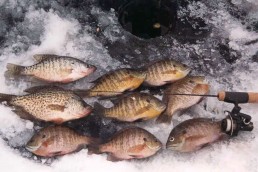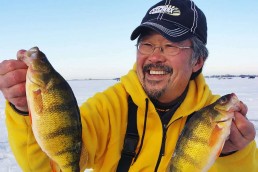Tactics for Early-ice ‘Gills and Crappies
SHARE THIS POST
With the ice season getting under way this month, it may be the first time that many have been on the water for some time now. For the hardcore fisherman, it may have only been a few weeks. But if you’re on either side of the coin, please make sure that the ice is safe before you make your way out.
For many, panfish will be the winter target and a few walleyes. With early-ice ‘gills and crappies, weeds will still come into play as the snow has not piled up yet on the ice, blocking out any sunlight. For the first few weeks of early ice, enough sun will continue to get through ice, allowing some weeds to stay up, and green. This will allow shallow sight fishing for ‘gills and crappies to come into play. With any weeds that are up and green, the shallows will still be filled with minnows and enough food to keep ‘gills in the shallows and worth your time to target during your first few trips to the ice.
Sight fishing
Sight ice fishing has been in the hardcore ice circles for many years, and is starting to be talked about by all. To best practice ice sight fishing you’ll need to be in a shelter, so getting out of the light is key. Also, fishing in a clear-water environment is a must. In fact, Clam is now making a shelter just for sight fishing that’s made out of light-out black material, allowing very little light into the shelter that makes it easier to see down into the water.
For sight fishing, you’re better off not using electronics. You should be able to see fish coming in below you and you can also see the bite as it all unfolds. I believe the pinging from a transducer can keep fish away in the more shallow waters below ice.
When it comes to bait selection, I always have both live bait and plastics presentations. Use bright-colored jigs and whites, as these will be visible to the ‘gills and crappies in the shallows. The glow options will not be needed. Because you are in shallow water on the days fish are active, I’ll opt to use a tungsten ice jig, and on the days after cold fronts have passed and the fish seem to be off a little, I’ll go to a smaller lead jig and downsize my jig to get a slower fall to trigger more bites.
Weed flats
As the shallower weeds start to die off, fish located in the shallows will start to move deeper, moving the bigger fish out on the flats toward the outside edges. I’ll make this point: Most of the biggest ‘gills and crappies are not shallow-based, but will mostly spend their lives in mid-flat depths and deeper. There may be one time when they make appearances in shallower water, and that’s to spawn in springtime. Most of the time they will be located at mid-flat depths and deeper. In these green weeds, oxygen will be given off and holding fish will still be there. When looking for the best flat areas, look for weeds that are located close to or have access to deep water. When the shallower weeds die off, this will push the ‘gills and crappies deeper. When these deeper weeds die off as the snow piles up, the fish will get deeper and they’ll stay associated only with green ones. Targeting weed flats can be a little tricky. Yes, you can roam the weed areas punching holes here and there and drop down a bait to see what is in the area, but the best way to target large weed flats is to know where some of the hard-bottom areas are. I will do a lot of offseason scouting, and locking these key waypoints into my ice unit to use at these certain times helps.
Are you enjoying this post?
You can be among the first to get the latest info on where to go, what to use and how to use it!
I’ll fish with a Humminbird Helix 7 loaded with a LakeMaster chip during the open-water season. Or before ice-up, I’ll make it a goal to hit the water and do some last-minute scouting. I’m looking for weed conditions and hard-bottom areas in the weeds I know fish will target as they get pushed deeper out onto the flats. Often, these are the areas that the bigger bulls and slabs will use during the fall for getting ready for winter. Again, once you find these key spots, put down a few waypoints so you can get back into these areas when needed. Now, you may need to drill a few holes in the areas, as they will move around looking for food or move with the fishing pressure. So you may have to do a little hunting when you get into these key areas to locate those targeted fish.
With live bait and plastics, as I move deeper I will start to employ a two-hole-presentation tactic. In one hole I will use a plastics presentation and in the other I will drop down a slip bobber-rig with live bait. This will give me the best of both offerings and will also clue me into what they want that day on the ice. You will have days when one presentation will be preferred over the other, and you know it never hurts to have live bait down the hole as an attraction.
Weed edges
Once again, the eventual deeper snow cover on the ice blocking out more sun will be the driving factor behind fish migration. The lack of light will kill weeds here. But fish will use weeds in the edges that are still green and up to target food or for any cover for protection. The ‘gills will take up residence in these weeds and you will see crappies start to use the edges for feeding areas, but they will spend more time suspending in open-water areas when not feeding.
To find these suspending crappies holding off of the weed edges, use your electronics to get a clue as to the depth of the top of the weeds. For example, if the weed edge is located in 18 feet of water and the tops of the weeds are located in 14, the crappies will make horizontal movements off of the weed edge and hold in water depths between 14 to 16 feet. When they want to eat they will make movement toward the weed edge to disperse to eat, then regroup again to hold off of the weedline until it’s time to eat again.
Once again, I will use both live bait and plastics along with the two-hole presentation in my shack. At these deeper depths glow-jig finishes will come into play, especially as snow gets deeper on the ice, limiting light penetration. Use this to your advantage. Also pay attention to bite “moods” of the fish. If they are active fish and you’ve been using tungsten and you’re fishing in post-frontal conditions, switch to a lead jig to get a slower fall to keep your bait in the strike zone longer.
Early ice provides the best ice fishing of the season, but you have to stay light and mobile to take advantage any opportunities. And if you are not on the bite, it’s time to move and search for the active fish.
MWO
SHARE THIS POST
Did you enjoy this post?
You can be among the first to get the latest info on where to go, what to use and how to use it!
Scott Petersen
Scott Petersen has been writing for the past 30 years. A Minnesota native, he has a passion to fish all seasons on ice and open water. “One of my main goals is to teach people how to fish through my articles and sport-show seminars.”



